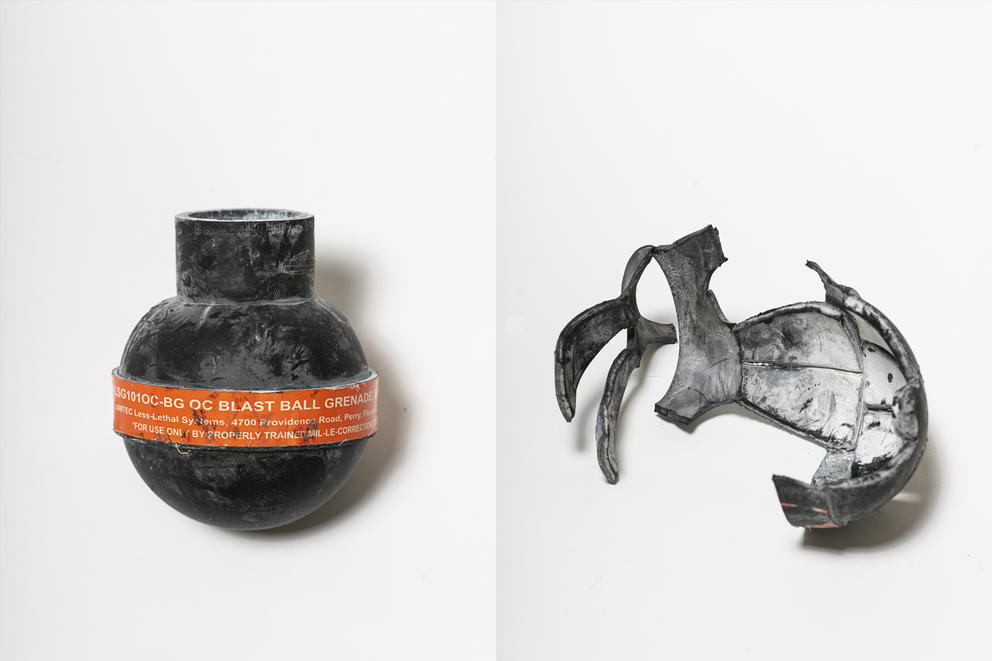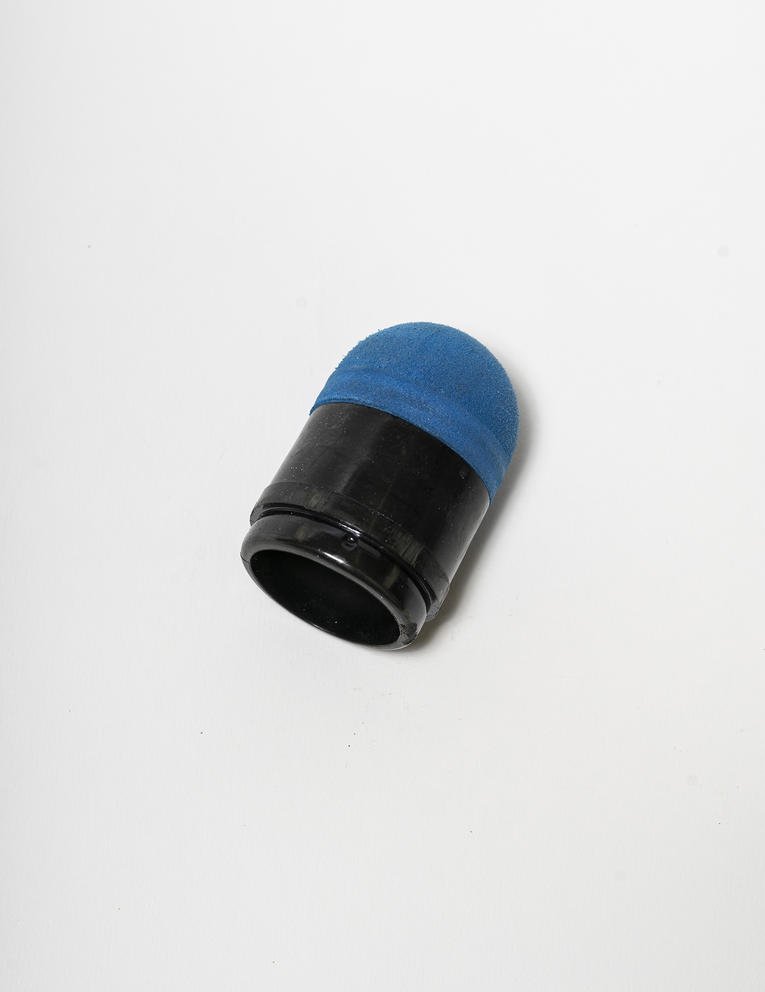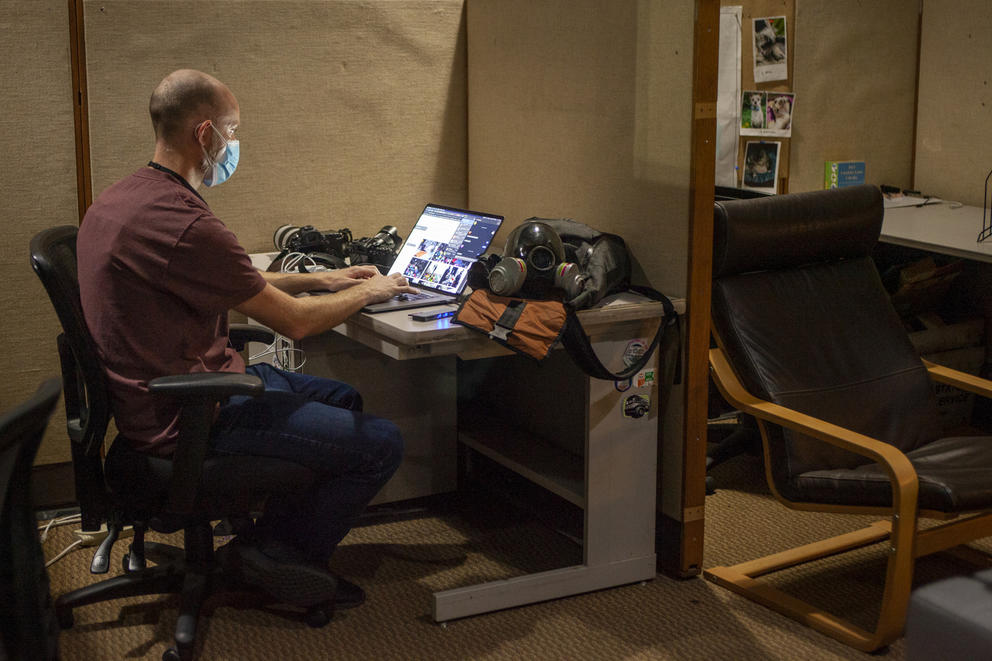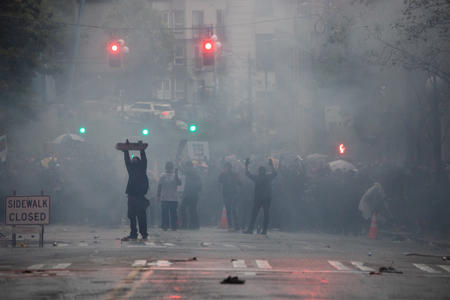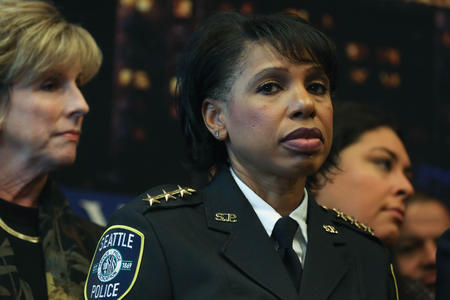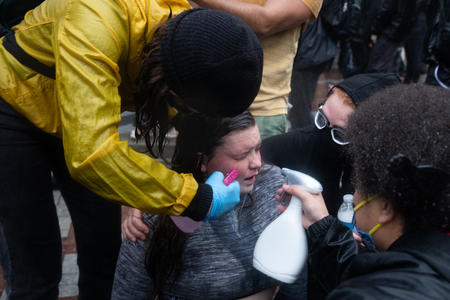“It’s something I will run away from as quick as I can, if I see one coming at me,” says photojournalist David Ryder about the tennis-ball-sized grenades deployed by police at recent protests. “They’re pretty scary. They're loud and it's not good for your hearing. And they can hurt people really bad.”
In his decade as a Seattle-based photographer, and particularly in the past months, Ryder has dodged his fair share of blast balls. Police officers have been bowling or lobbing these rubber ball blast grenades into the crowds of people protesting against police brutality and systemic racism, sparked by the killing of George Floyd. When one lands nearby, Ryder knows there’s not much time to think — let alone take a clear photo.
In a new, stark series, Ryder strips away the chaos and confusion of the protests, and examines these “crowd control” weapons out of context on a clean, white background. Using the techniques of still-life studio photography, Ryder focuses on the blast balls and various parts of foam projectiles deployed by the Seattle Police Department during recent protests on Capitol Hill.
“We hear and read about these objects, but I didn’t know what they really looked like,” Ryder says of the series, called Crowd Control. “It’s interesting to see these things up close.”
The use of so-called “less lethal weapons" has long been controversial, with one injured man suing the city in 2016 for its use of blast balls. Recently, the weapons came under scrutiny again, and the Seattle City Council banned their use. That ban was subsequently blocked — meaning police are not prohibited from using pepper spray, blast balls and similar weapons.
A 40 mm 'exact impact' sponge round, a 'less-lethal' munition used by Seattle Police for crowd control during the July 25 protests for racial justice, photographed on July 26, 2020, in Seattle. (David Ryder)
Motionless and devoid of their dangerous capabilities (despite being called nonlethal or “less lethal,” blast balls and their shrapnel can result in serious injury and even death), these weapons become part journalistic documentation, part captivating art objects.
“The stark white [backdrop] allows you to contemplate,” Ryder says. “You can't look away from it, you can't look around it.”
Usually, Ryder mostly shoots outside, covering everything from forest fires to the U.S.-Mexico border to ski jumpers suspended in midair for news organizations including Reuters, Getty Images, Bloomberg, as well as major newspapers like the Wall Street Journal and the New York Times. Crowd Control is a personal side project somewhere in between art and documentary photography, he says; a way to explore something new in between his freelance assignments.
But after weeks of covering the protests in the city, something clicked for Ryder on July 25. On that day, police and protesters clashed on Capitol Hill, with officers “constantly throwing blast balls,” as Ryder puts it. “I noticed more littering the street than I had ever seen before,” he recalls.
Then he saw one that hadn’t shattered to pieces.
“Strange,” he thought as he instinctively reached for it. “You don't see them fully intact, usually. They just blow apart.” He swiftly swaddled it in a backpack rain cover he found on the ground nearby, careful not to touch the device. Then he saw something else: a blue foam tip, a high-speed projectile (colloquially known as a rubber bullet). Police deploy these with a riflelike “Less Lethal Launcher” (officially restricted to shooting at protester’s buttocks, thighs, calves and large muscle groups). “This stuff is everywhere,” he recalls thinking. He grabbed it, along with its launching cartridge.
The next day, Ryder transformed his living room into a photo studio with the help of a strobe lamp and piece of paper held down by a pile of magazines on a rug. It was quick and dirty — no tripod, just a hand-held camera. “The hardest part was keeping the cat from sniffing around,” Ryder says. “I coughed a little bit. There seemed to be a fair amount of white powder.”
Keeping a curious cat away from chemical irritants like OC powder (pepper spray) sounds like a surreal scene, but Ryder says it doesn’t even make his top 10 strangest moments of 2020. In February, he literally zoomed in, from afar, on locked-in residents of the Life Care Center in Kirkland, the assisted living facility that emerged as the original epicenter of the U.S. coronavirus outbreak. His shot of an elderly woman and her daughter separated by a window made the cover of Time. Ryder’s work made headlines again when Fox News digitally altered two of his photos to create a misleading collage of what was then becoming the Capitol Hill Autonomous Zone.
But the strangest moment of all came in early June, when, on the 11th day of the protests, Ryder says, “all hell broke loose.” Explosions. Screaming. Armored vehicles rolling through eerie clouds of tear gas, while in the distance, Ryder heard Bob Marley’s “Is This Love" drifting through the air from outdoor speakers.
Sitting on the fire escape of the offices of local alt-weekly The Stranger, where many reporters were livestreaming and working, Ryder remembers thinking this was a front-row seat to history if there ever was one.
“I had never seen the violence and use of crowd control on that scale before,” Ryder says. “I’ve been around blast balls here and there, but [this time] it was just constant. Constant explosions. Like you’re in a war zone.”
There’s no such mayhem in Crowd Control. Ryder places the remnants of the weapons in quiet, blank space. In doing so, he follows in the footsteps of other photographers who have taken a “forensic turn,” using clean and simple full-frontal close-ups of objects to tell human stories: refugees’ beat-up shoes standing in for their long trek, clothes evoking those murdered in El Salvador or the photos and postcards left behind by those killed in the Bosnian War. Though lacking scale or measurement, they resemble crime-scene photographs, evidence collected after the action has retreated.
“I wanted to present this stuff without judgment on this white backdrop. Just to say: here it is, you can judge for yourself,” Ryder says. “That said,” he adds, “lobbing a thing that says ‘grenade’ into a crowd of people, it’s a violent thing.” Take the blast ball grenade that first caught his eye; it looks “sort of warlike,” almost like “one of those cartoon-shaped bombs,” he says.
In Ryder’s photos, this loud, violent object suddenly becomes still. Historically and today, still lifes have been on the lowest rung of the painterly and photojournalistic ladder. There are no people, no action to capture. But as artists and photojournalists like Ryder have found, sometimes a collection of fragments can tell a fuller story.
Get the latest in local arts and culture
This weekly newsletter brings arts news and cultural events straight to your inbox.

